In today’s fast-paced world, the bedroom should be more than just a place to sleep; it should be a sanctuary, a haven of tranquility where you can truly unwind and recharge. Enter the Japandi bedroom, a design style that’s taking the interior design world by storm. Fusing the best of Japanese minimalism and Scandinavian functionality, the Japandi bedroom offers a unique aesthetic that is both calming and stylish.
If you’re looking to create a bedroom that promotes peace and serenity, then exploring the Japandi style bedroom is the perfect place to start.
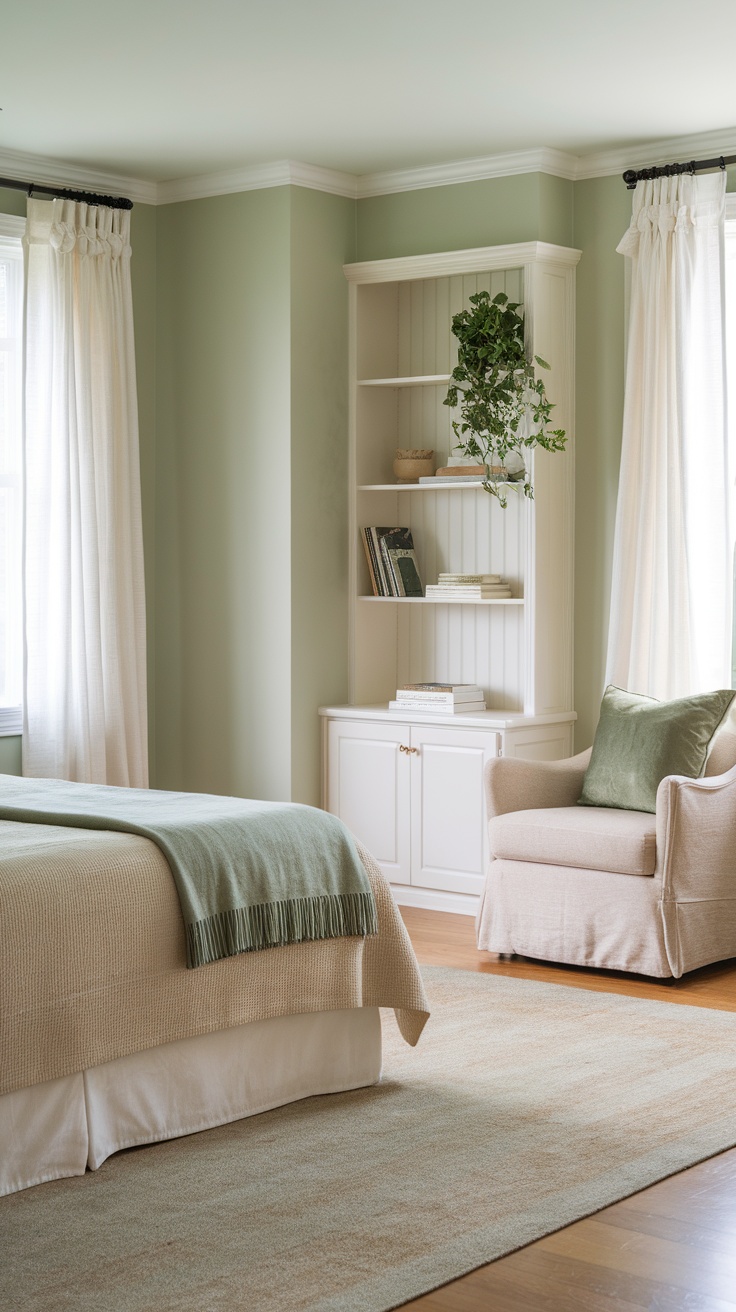
What is a Japandi Bedroom? – Unveiling the Fusion of Japanese and Scandinavian Design
Before diving into how to create your own Japandi oasis, let’s understand the core of this captivating style. So, what is a Japandi bedroom exactly? It’s a harmonious blend of two distinct yet surprisingly complementary design philosophies: Japanese and Scandinavian.
Defining Japandi Style: A Harmonious Blend
Japandi style isn’t just a trend; it’s a thoughtful approach to living that emphasizes simplicity, natural elements, and functionality. It takes the serene minimalism and appreciation for nature inherent in Japanese interior design and marries it with the warmth, comfort, and practicality of Scandinavian design. Think of it as the best of both worlds: the Zen-like calm of Japan meeting the cozy hygge of Scandinavia.
The result is a style that is uncluttered, refined, and incredibly inviting. It’s about creating spaces that are both beautiful and functional, promoting a sense of peace and well-being. This fusion extends beyond just aesthetics; it’s about embracing a lifestyle that values mindful living and a connection to nature.

Why is Japandi Interior Design Bedroom So Popular?
The popularity of the Japandi interior design bedroom stems from its ability to create spaces that feel both modern and timeless. In a world saturated with visual noise, the simplicity and understated elegance of Japandi offer a refreshing contrast. But beyond aesthetics, there are deeper reasons for its appeal:
- Calming Atmosphere: The emphasis on natural materials, neutral colors, and minimal clutter naturally creates a calming and relaxing environment, perfect for a bedroom.
- Functionality: Japandi design prioritizes functionality and practicality. Every element in a Japandi style bedroom serves a purpose, contributing to a sense of order and efficiency.
- Timeless Elegance: By focusing on quality materials and understated design, Japandi bedrooms avoid fleeting trends, offering a timeless elegance that will remain stylish for years to come.
- Connection to Nature: Both Japanese and Scandinavian design traditions value a strong connection to nature. Incorporating natural materials and bringing the outdoors in creates a sense of grounding and tranquility within the bedroom.

Key Elements of a Japandi Style Bedroom
Now that we understand the essence of Japandi, let’s delve into the key elements that define a Japandi style bedroom. Understanding these core components will help you recreate this aesthetic in your own space.
Minimalism and Functionality in Japandi Style Bedrooms
At the heart of japandi bedroom design lies minimalism. Clutter is the enemy of serenity in Japandi style. This doesn’t mean stark and empty; it means intentional and curated. Every item in the room should have a purpose and contribute to the overall aesthetic.
Functionality is equally important. Japandi style bedrooms are designed for living, not just for show. Furniture should be practical and comfortable, storage should be integrated seamlessly, and the layout should promote ease of movement and flow. Think clean lines, simple forms, and a focus on quality over quantity.
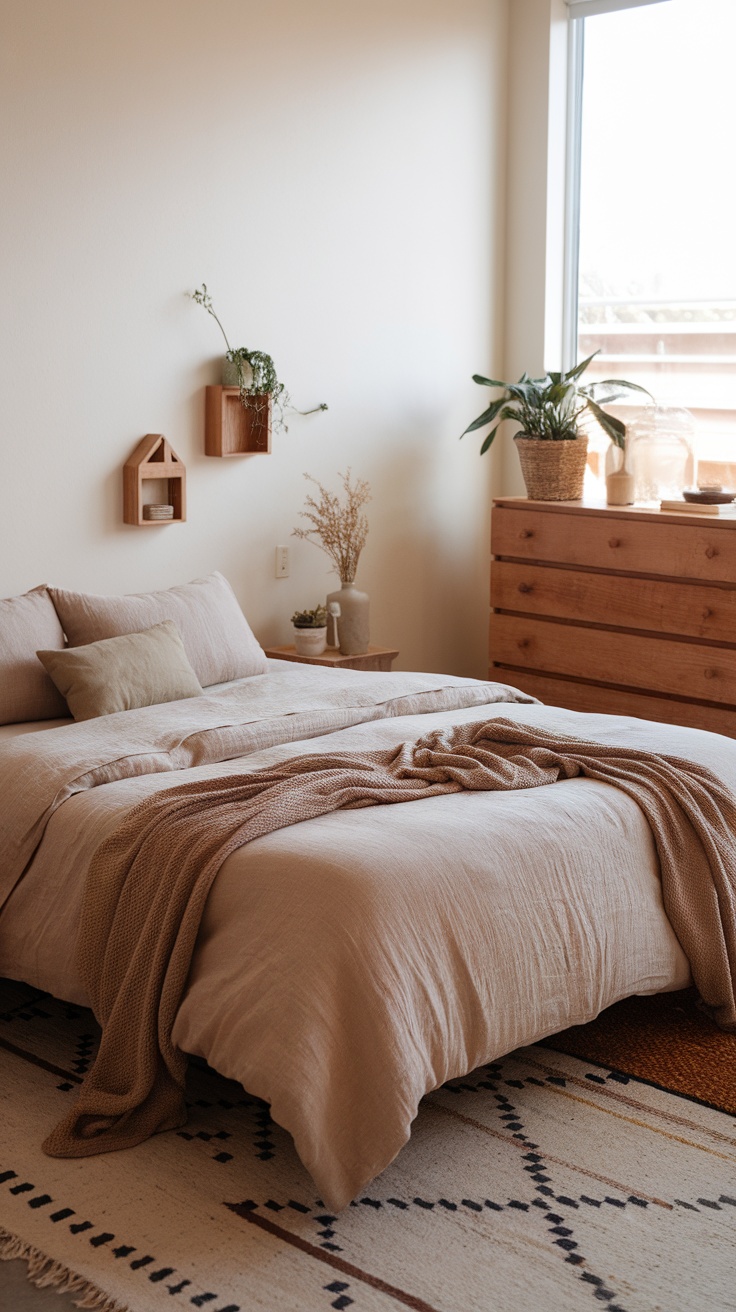
Natural Materials: The Foundation of Japandi Bedroom Design
Both Japanese and Scandinavian design traditions deeply value natural materials. In a japandi bedroom, you’ll find an abundance of wood, particularly light woods like pine, birch, and oak, reflecting the Scandinavian influence. However, darker woods like walnut and bamboo, hinting at Japanese aesthetics, can also be incorporated to add depth and contrast.
Other natural materials like linen, cotton, wool, and rattan are crucial for textiles and decor. These materials add texture and warmth, creating a tactile and inviting space. Stone and ceramics can also be introduced through accessories and decorative elements, further grounding the room in nature.
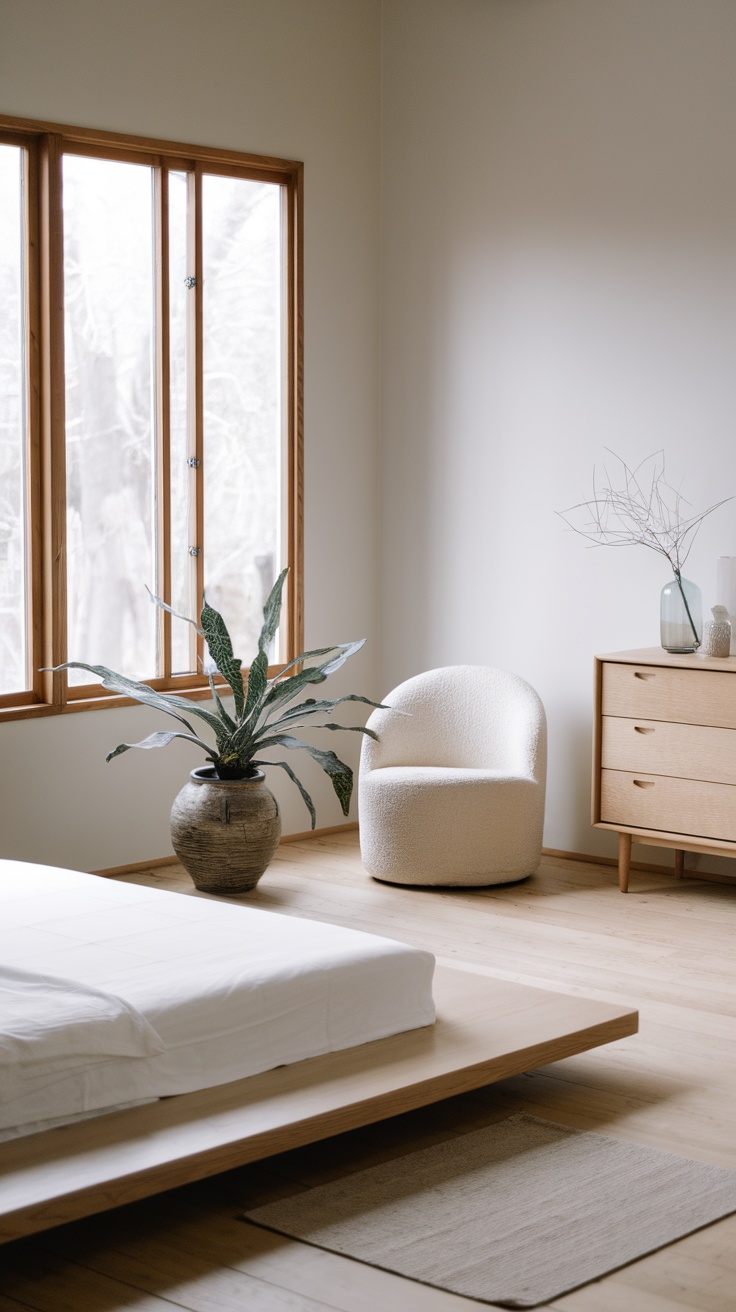
Japandi Bedroom Color Palette: Embracing Neutrality and Earth Tones
What colors are best for a Japandi bedroom? The color palette of a japandi bedroom is typically muted and neutral, drawing inspiration from nature. Think soft whites, creams, beiges, and light grays as the foundation. These light and airy tones create a sense of spaciousness and tranquility.
To add depth and warmth, introduce earth tones like muted greens, browns, terracotta, and even subtle blush pinks. Black accents are often used to create contrast and define lines, echoing the Japanese aesthetic. The key is to maintain a sense of harmony and avoid overly bright or jarring colors.

Designing Your Japandi Bedroom: Practical Tips & Ideas
Ready to start designing your own japandi bedroom? Here are practical tips and inspiring japandi bedroom ideas to guide you:
How to Design a Japandi Bedroom: Step-by-Step Guide
- Declutter and Simplify: Begin by decluttering your existing bedroom. Remove anything that doesn’t serve a purpose or bring you joy. Embrace the minimalist spirit.
- Choose a Neutral Color Palette: Start with a base of soft white or light gray for the walls. Layer in subtle earth tones through textiles and accessories.
- Incorporate Natural Materials: Focus on natural materials for furniture, flooring, and decor. Opt for a japandi style bed made of natural wood, linen bedding, and wool rugs.
- Maximize Natural Light: Keep window treatments minimal to maximize natural light. Sheer curtains or simple blinds are ideal.
- Choose Functional and Minimalist Furniture: Select furniture with clean lines and simple forms. Prioritize functionality and quality over ornate details. A low platform japandi style bed is a quintessential piece.
- Introduce Texture: Layer in texture through natural textiles like linen, cotton, wool, and rattan. This adds visual interest and warmth to the neutral palette.
- Add Greenery: Bring the outdoors in with carefully selected plants. Orchids, bonsai trees, and snake plants are excellent choices for a japandi bedroom, adding a touch of life and freshness.
- Incorporate Art and Decor with Intention: Choose artwork and decor pieces that are meaningful and contribute to the overall serene atmosphere. Keep it minimal and curated. Japandi bedroom decor inspo often includes minimalist ceramics, woven baskets, and simple wall art.
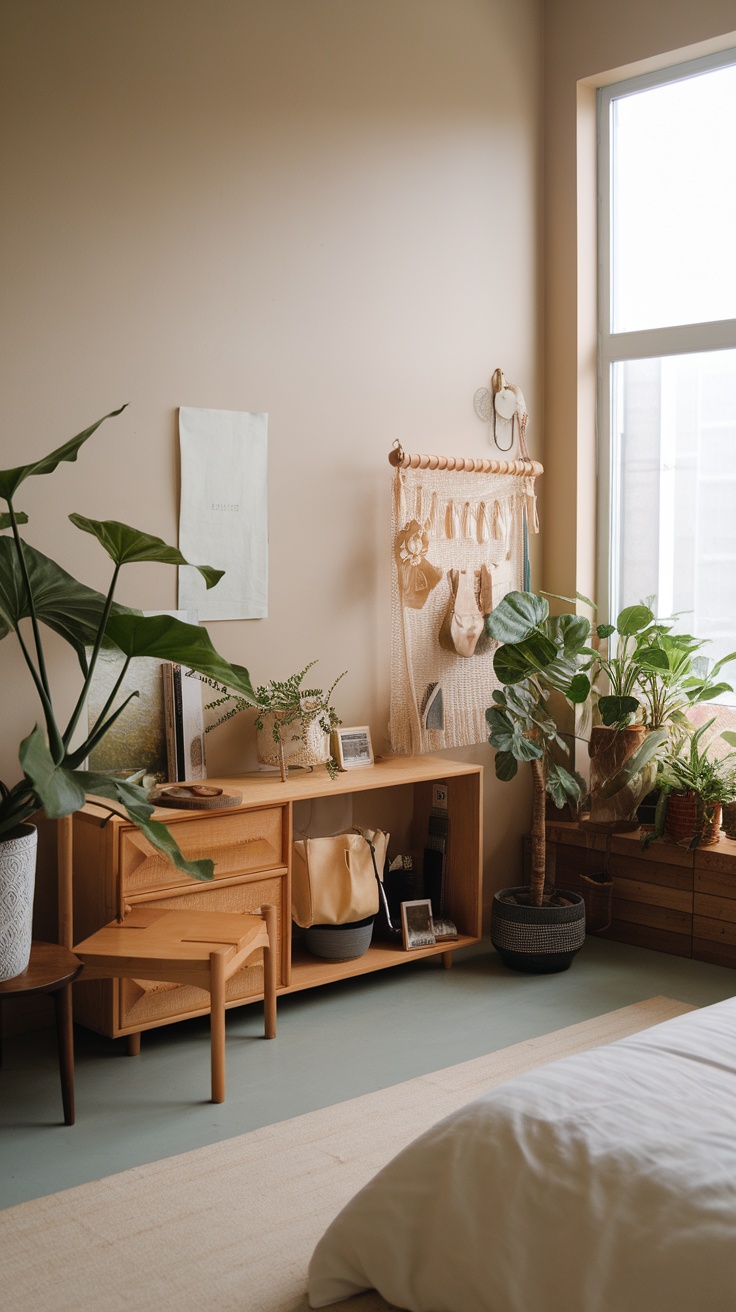
Japandi Bedroom Ideas to Inspire Your Space
- Platform Bed Focus: Make a low platform japandi style bed the centerpiece of the room. Keep bedding simple and elegant with natural linen sheets and a muted color palette.
- Nature-Inspired Headboard: Consider a headboard made of natural woven materials or reclaimed wood for a touch of organic texture.
- Minimalist Nightstands: Opt for simple, minimalist nightstands in natural wood. Keep surfaces clear and uncluttered.
- Statement Lighting: Choose lighting fixtures that are both functional and aesthetically pleasing. Paper lanterns, minimalist floor lamps, and pendant lights in natural materials can enhance the Japandi ambiance.
- Zen-Inspired Corner: Create a small Zen-inspired corner with a comfortable chair, a small side table, and a calming piece of art or a plant. This can become a dedicated space for reading or meditation.
- Sliding Doors: If possible, incorporate sliding doors or shoji screens to further enhance the Japanese influence and create flexible space division.
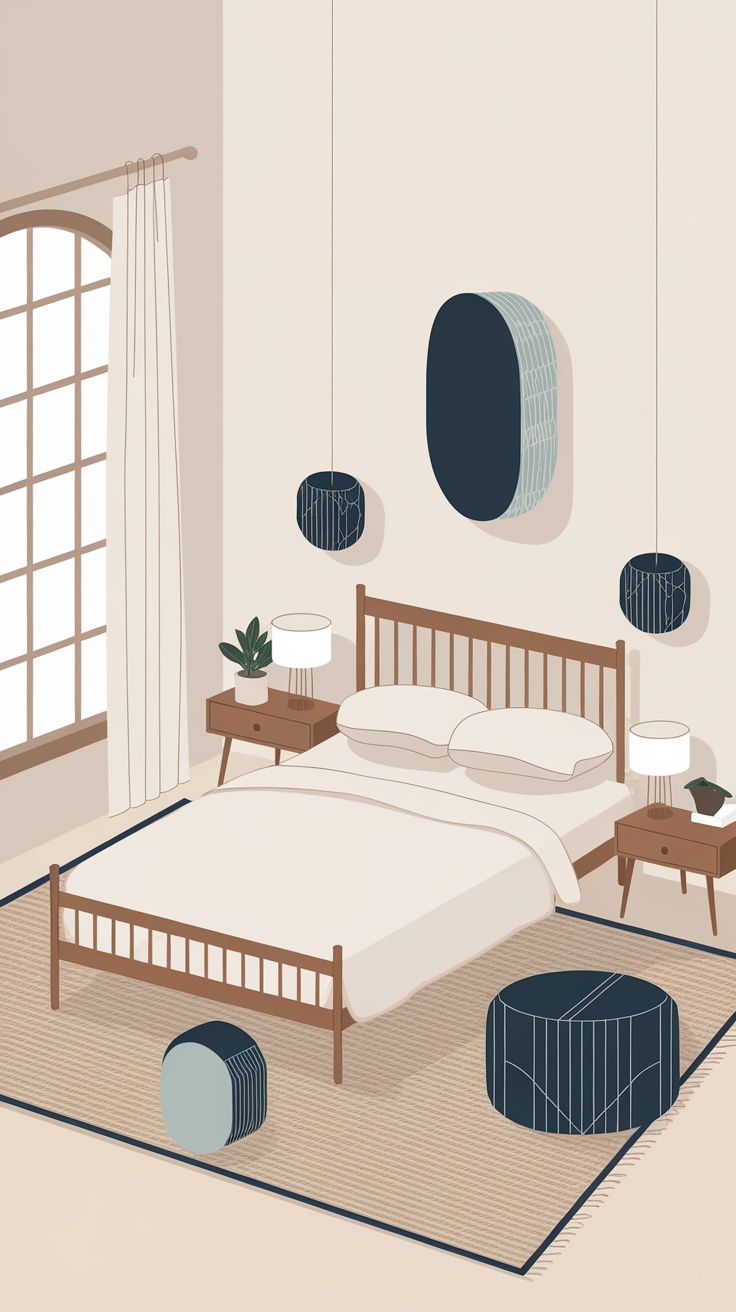
Japandi Bedroom Design for Small Spaces
Japandi bedroom design is particularly well-suited for small spaces. The minimalist approach and focus on functionality help to maximize space and create a sense of openness. Light colors, minimal clutter, and clever storage solutions are key to making a small japandi bedroom feel spacious and serene. Utilize vertical space with floating shelves or tall, slender storage units to keep the floor area clear.

Choosing the Perfect Japandi Style Bed and Furniture
The bed is undoubtedly the focal point of any bedroom, and in a japandi bedroom, the japandi style bed plays a crucial role in setting the tone.
What Furniture Suits a Japandi Style Bed? – Key Pieces
To complement your japandi style bed, choose furniture pieces that share the same design principles:
- Nightstands: Minimalist nightstands in natural wood, ideally with drawers for discreet storage.
- Dressers: Low, horizontal dressers with clean lines and minimal hardware.
- Wardrobes: Consider built-in wardrobes or freestanding wardrobes with simple, uncluttered designs.
- Seating: A simple, comfortable armchair or a small bench in natural materials can add a touch of comfort without disrupting the minimalist aesthetic.

Japandi Style Bed: Low Platforms and Natural Wood
The quintessential japandi style bed is a low platform bed. This design element is directly inspired by Japanese tatami rooms and promotes a grounded and calming feeling. Opt for a japandi style bed crafted from natural wood, such as oak, pine, or walnut. Avoid ornate details and prioritize clean lines and simple forms. The focus should be on comfort and understated elegance.
Japandi Bedroom Decor Inspo: Accessorizing with Intention
Japandi bedroom decor inspo emphasizes quality over quantity. Accessories should be carefully chosen to enhance the overall aesthetic and contribute to the serene atmosphere.
- Textiles: Linen bedding, wool rugs, and cotton throws in neutral tones are essential for adding texture and warmth.
- Ceramics: Minimalist ceramic vases, bowls, and decorative objects add a touch of handcrafted elegance.
- Artwork: Choose simple and understated artwork, such as abstract prints, nature photography, or calligraphy. Keep it minimal and avoid overly busy or distracting pieces.
- Lighting: Paper lanterns, minimalist lamps, and candles create a soft and ambient light, enhancing the calming atmosphere.
- Greenery: Plants are essential for bringing life and freshness into a japandi bedroom. Choose species that thrive indoors and complement the minimalist aesthetic.
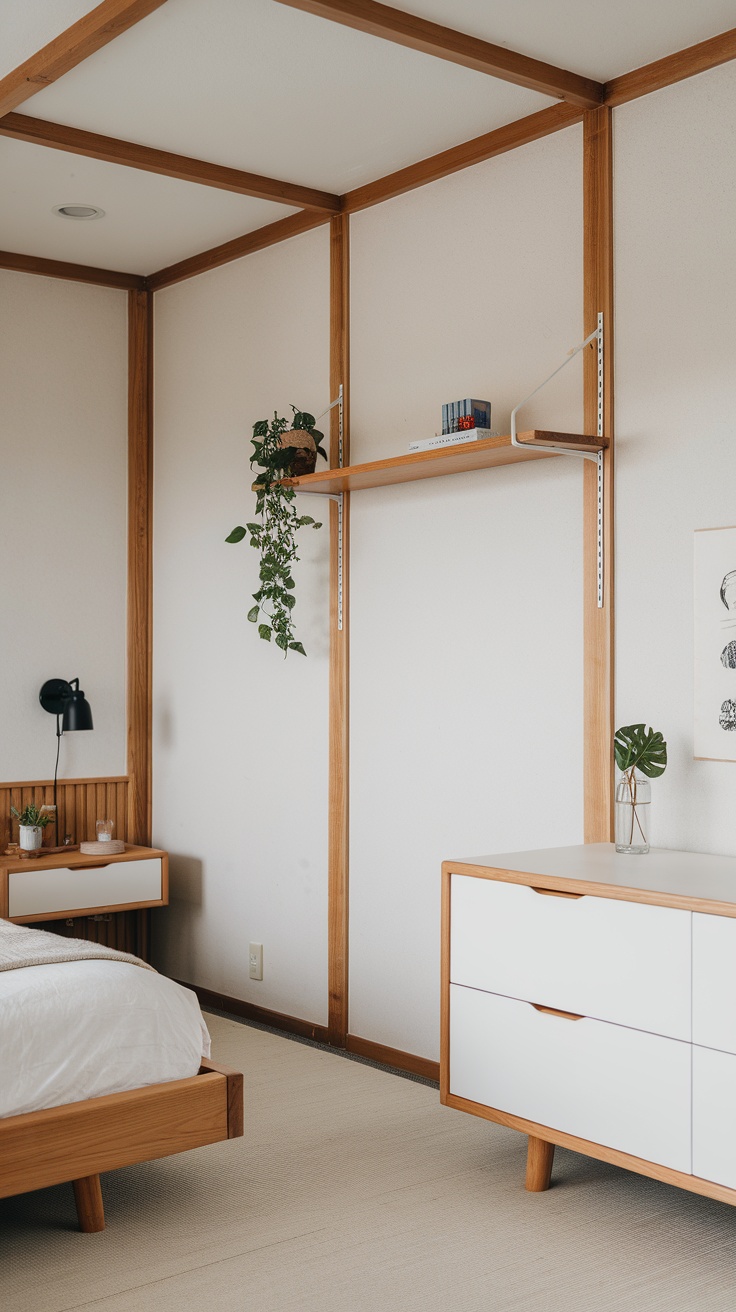
Scandinavian Japandi Bedroom: Understanding the Nuances
The term “scandinavian japandi bedroom” further clarifies the blend of these two styles. While Japandi is inherently a fusion, emphasizing the “Scandinavian Japandi” aspect highlights the slightly warmer and cozier elements drawn from Scandinavian design.
How Does Scandinavian Japandi Bedroom Differ? – Key Distinctions
While both Japandi and Scandinavian design share a love for minimalism and functionality, there are subtle differences:
- Warmth: Scandinavian design often incorporates warmer tones and textures to combat the long, dark winters. Scandinavian japandi bedrooms might lean slightly more towards warmer neutrals and cozier textiles compared to a purely Japanese-inspired Japandi bedroom.
- Hygge: The Scandinavian concept of “hygge” – coziness and comfort – is more pronounced in scandinavian japandi bedrooms. Think plush throws, soft lighting, and inviting textures.
- Color Palette Nuances: While both palettes are neutral, Scandinavian design can sometimes incorporate slightly bolder pops of color, albeit still muted. Scandinavian japandi bedrooms might feature subtle hints of blue, green, or mustard yellow alongside the core neutral palette.
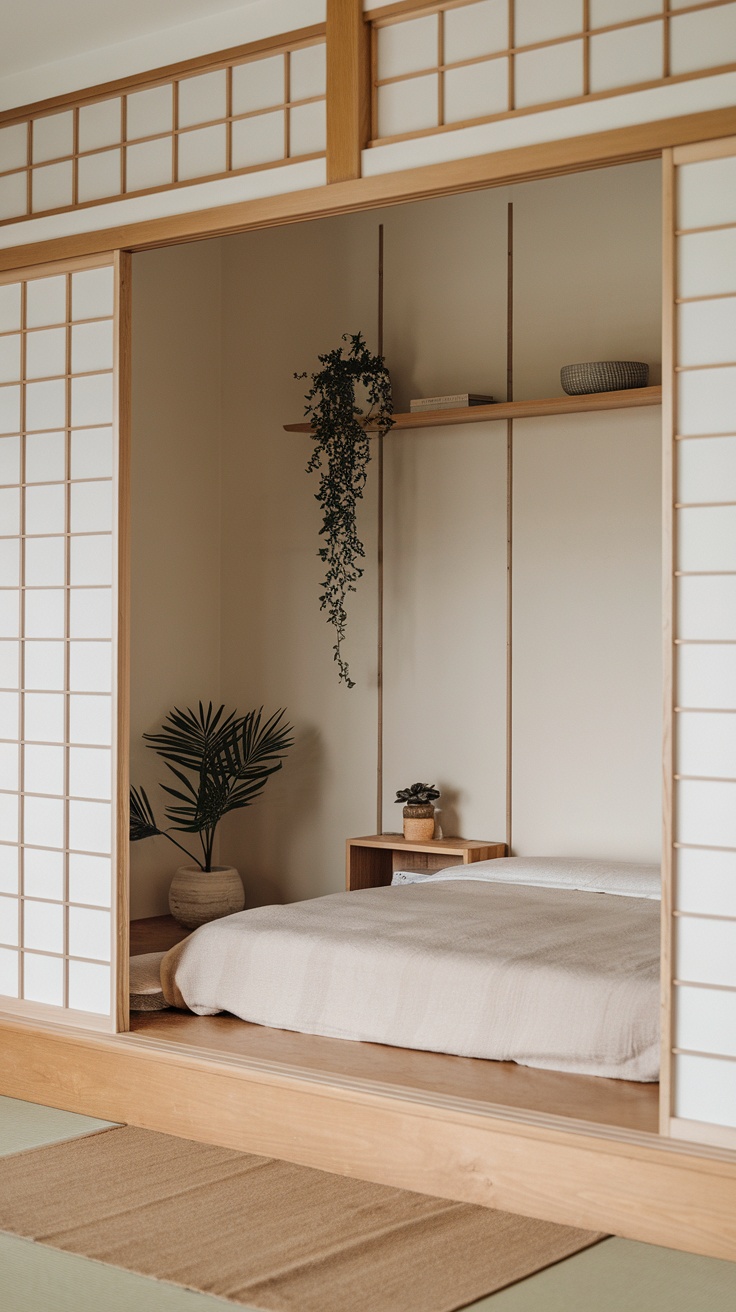
Creating a Scandinavian Inspired Japandi Bedroom
To lean into the “scandinavian japandi bedroom” aesthetic, consider these additions:
- Layered Textiles: Add extra layers of cozy textiles like sheepskin throws, chunky knit blankets, and plush cushions.
- Warmer Wood Tones: While light woods are still prevalent, incorporating slightly warmer wood tones like honey oak can enhance the Scandinavian feel.
- Candles and Soft Lighting: Emphasize soft, ambient lighting with candles, string lights, and warm-toned lamps to create a hygge atmosphere.
- Cozy Seating Nook: Create a dedicated seating nook with a comfortable armchair, a soft throw, and a side table for a truly inviting and cozy corner.
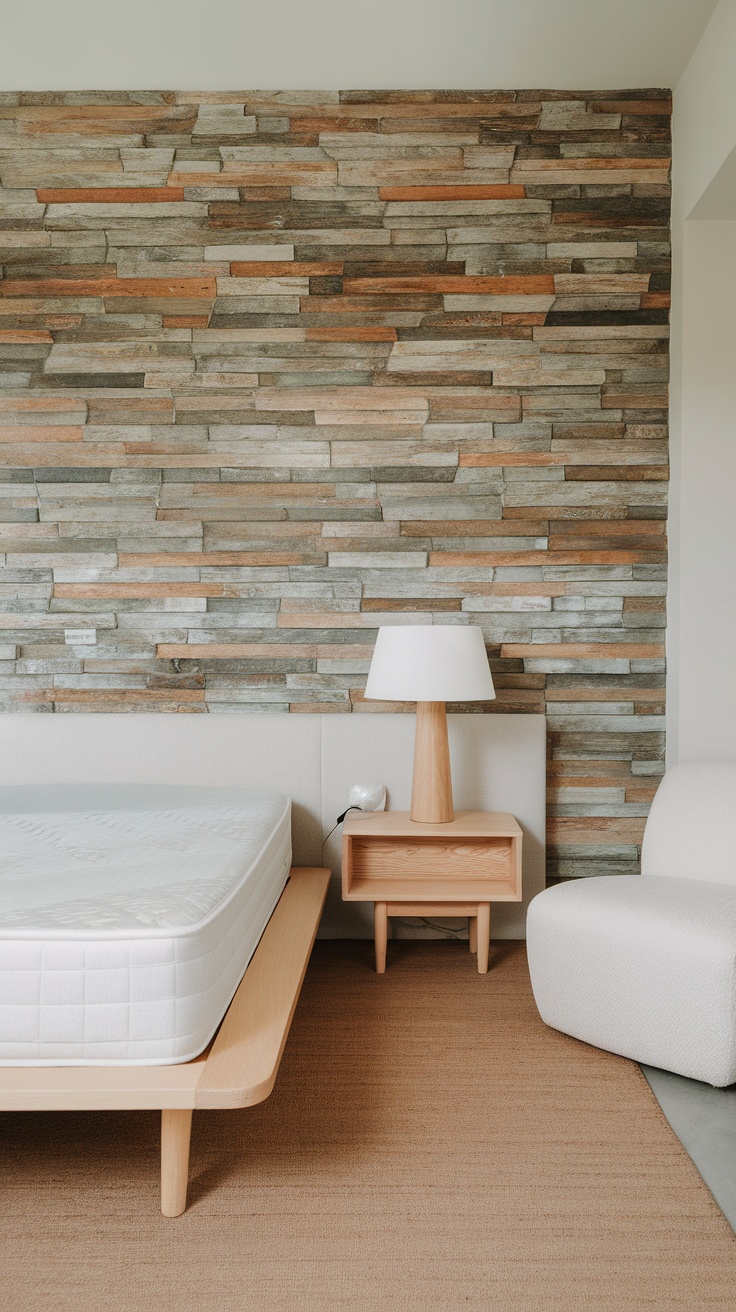
Frequently Asked Questions About Japandi Bedrooms
As mentioned earlier, the best colors for a japandi bedroom are neutral and earth-toned. Start with a base of soft white, light gray, or beige for walls. Layer in accents of muted greens, browns, terracotta, blush pink, and black for contrast. The key is to maintain a harmonious and calming palette.
Maintaining the serene atmosphere of your japandi bedroom is an ongoing process. Regular decluttering and organization are crucial. Make it a habit to tidy up daily and put things back in their place. Embrace mindful consumption and avoid accumulating unnecessary items. By consistently maintaining the minimalist principles, you can ensure your japandi bedroom remains a tranquil sanctuary.

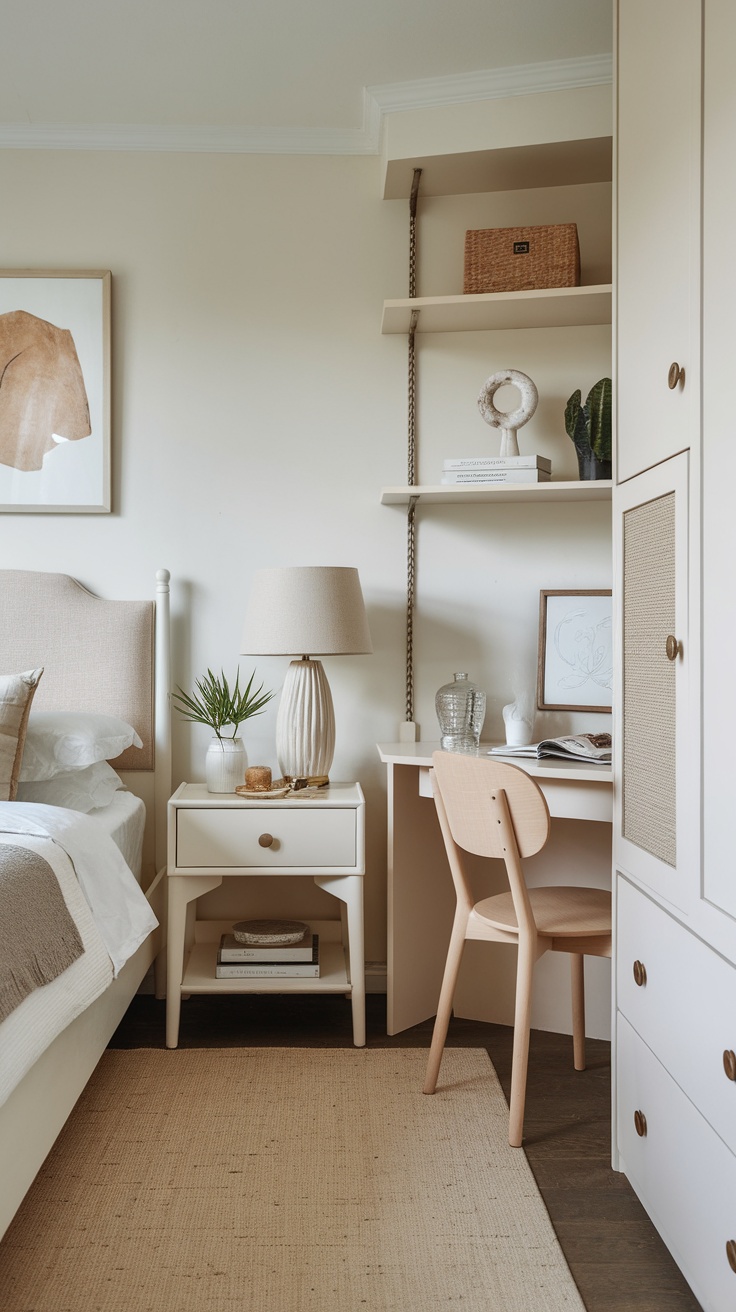
Conclusion: Embrace the Japandi Bedroom Trend for a Calming and Stylish Retreat
The japandi bedroom is more than just a design trend; it’s a lifestyle choice that prioritizes peace, functionality, and connection to nature. By embracing the principles of Japanese and Scandinavian design, you can create a bedroom that is not only beautiful but also promotes well-being and tranquility. Whether you’re drawn to the minimalist elegance, the natural materials, or the calming color palette, the japandi style bedroom offers a timeless and inspiring approach to creating your ultimate sleep sanctuary.
So, take inspiration from these japandi bedroom ideas, embrace the essence of japanese interior design japandi bed room aesthetics, and transform your bedroom into a haven of serenity and style.
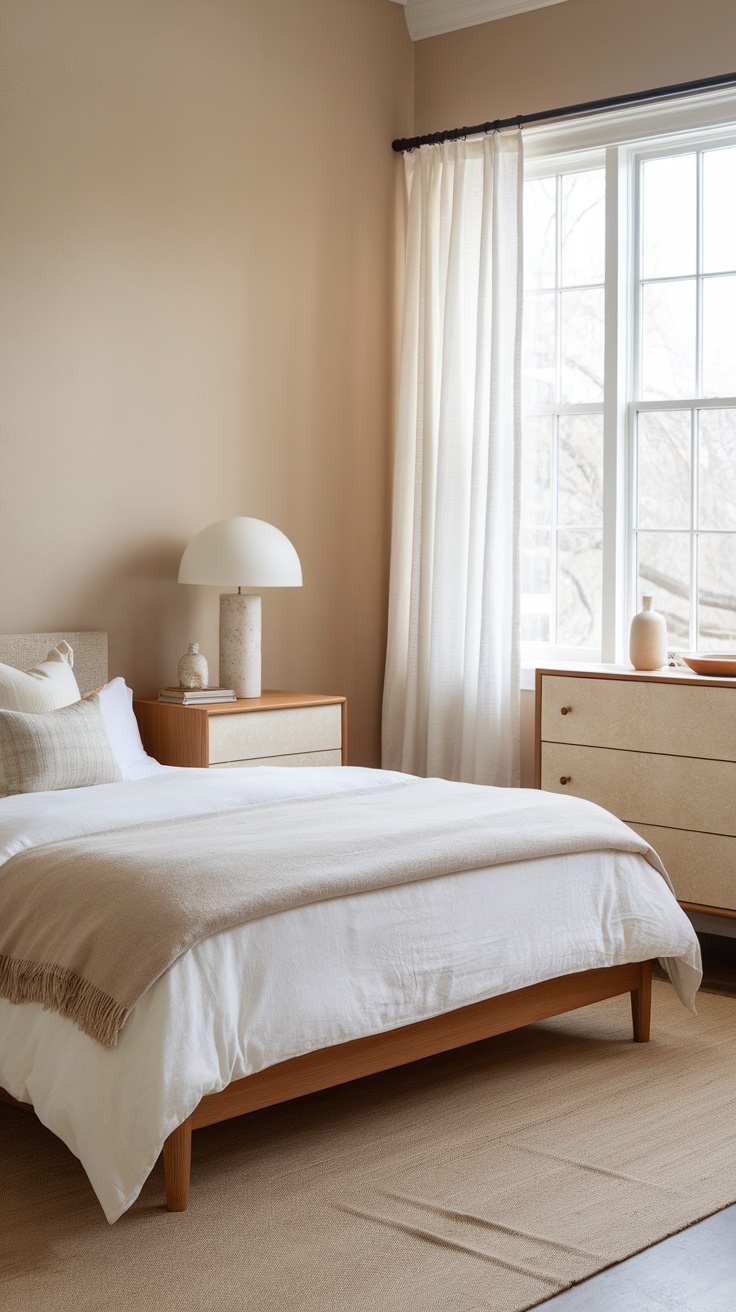





Pingback: Step Back into Glamour: Stunning Art Deco Bedroom -
Pingback: Mid-Century Modern Bedroom Timeless Style -